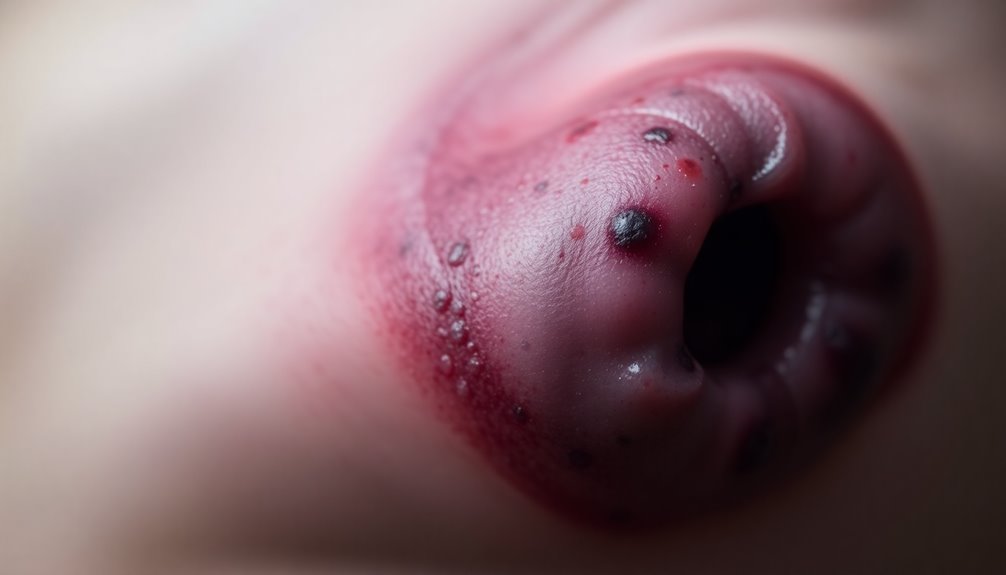To check for skin cancer using the ABCDEs, look for asymmetrical moles where one half doesn’t match the other, and watch for irregular, jagged borders. Pay attention to color changes, especially multiple hues or darkening. Measure moles regularly and note any growth or shrinkage over time. Early detection depends on noticing these signs early, so keep an eye on your skin’s appearance—continuing your examination will help you spot potential issues sooner.
Key Takeaways
- Use the ABCDEs: Asymmetry, Border irregularity, Color variation, Diameter over 6mm, and Evolution of moles or spots.
- Check for asymmetry by dividing moles to see if halves match in shape and size.
- Look for irregular, scalloped, or blurred borders around moles or spots.
- Monitor for multiple or uneven colors, including black, brown, red, white, or blue.
- Regularly measure and track changes in size, shape, or color to detect early signs of skin cancer.
Recognizing Asymmetry in Moles and Spots
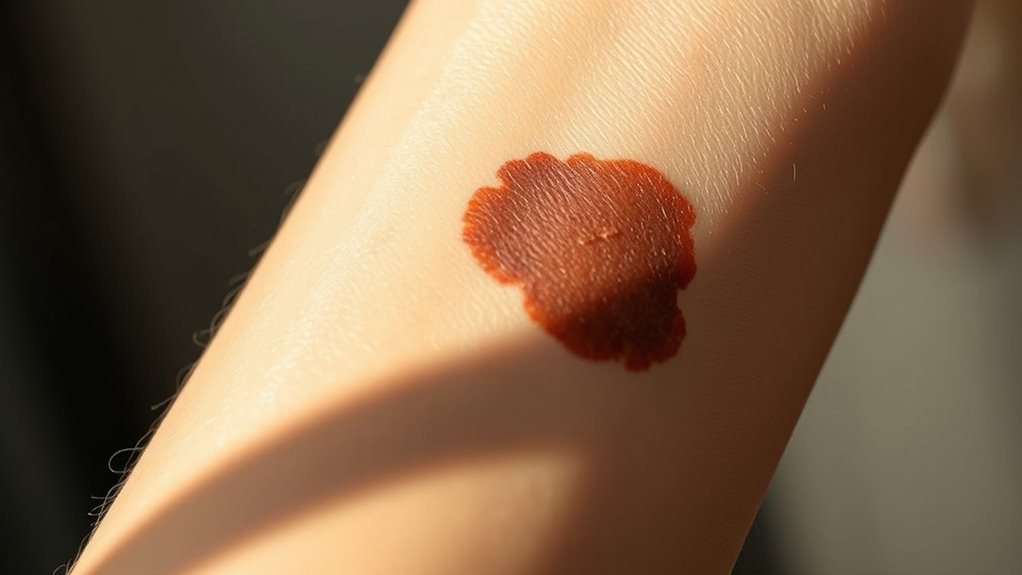
When examining your moles and spots, look for signs of asymmetry, which means one half doesn’t match the other in shape or size. If you draw an imaginary line through the middle of a mole, check if both sides mirror each other. Symmetrical moles tend to be regular and uniform. Asymmetry is a warning sign because cancerous moles often have uneven shapes. For example, one side may be jagged, irregular, or vastly different from the other. Don’t ignore irregular shapes, even if the mole isn’t large. Automation in healthcare advancements are improving early detection techniques, making regular self-exams even more important. Consistent asymmetry can indicate abnormal growth. Regular self-exams help you catch changes early, so pay close attention to whether your moles look balanced or uneven. Recognizing asymmetry is a key step in spotting potential skin issues early.
Identifying Border Irregularities
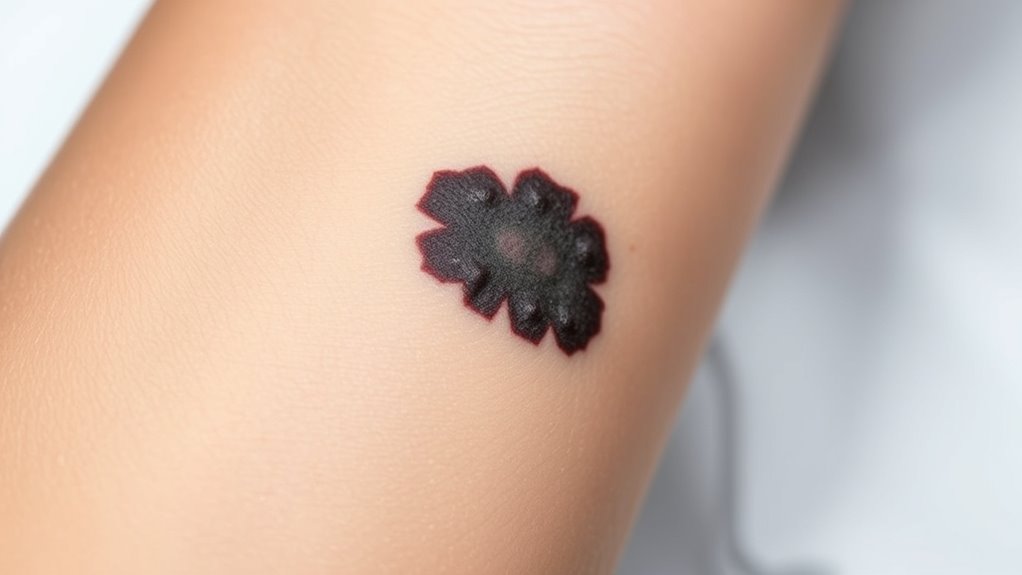
Irregular borders are another key sign to watch for when inspecting your moles and spots. Healthy moles usually have smooth, even edges. If you notice borders that are jagged, blurred, or ragged, it could be a warning sign of skin cancer. These uneven edges may appear to fade into the surrounding skin, rather than having a clear boundary. Pay close attention to how the borders look and feel—if they seem uneven or irregular, it’s worth getting a professional opinion. Here’s a quick guide to common border types:
| Border Type | Description |
|---|---|
| Smooth and even | Healthy, benign mole |
| Jagged or scalloped | Irregular, possibly concerning |
| Blurred or fuzzy | Edges fade into skin, suspicious |
| Notched or uneven | Irregular, warrants further check |
Stay alert to these signs for early detection.
Monitoring Color Variations and Changes
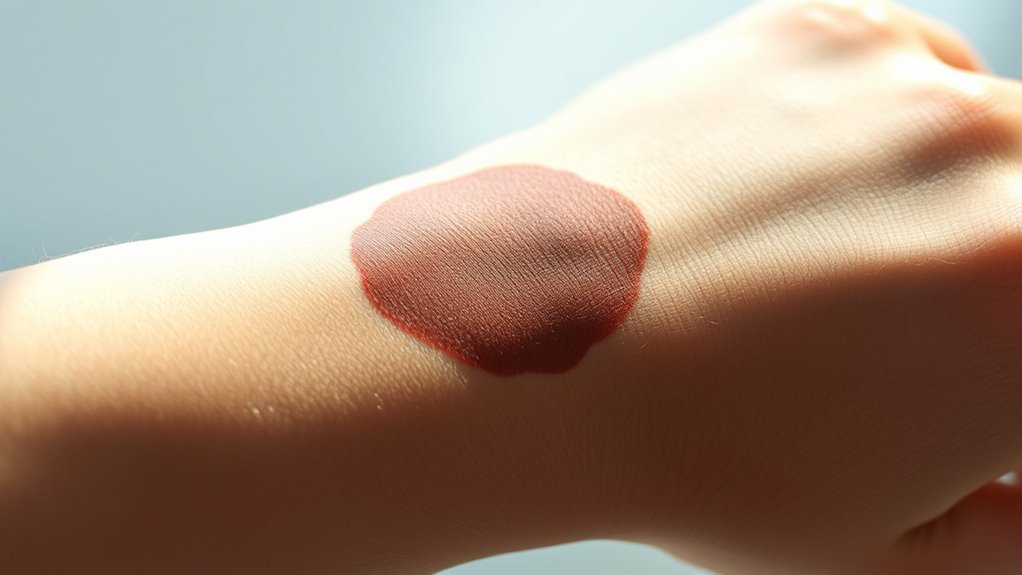
Monitoring the color of your moles and spots is essential because changes can signal the development of skin cancer. Keep an eye on any new colors or uneven pigmentation within existing moles, such as shades of black, brown, tan, red, white, or blue. Notice if a spot starts to darken or develop multiple colors, as this may be a warning sign. Sudden or irregular color changes, especially if they occur quickly, should raise concern. Remember, consistent color variation or the appearance of multiple hues within a single lesion can indicate abnormal growth. Regularly checking for these color shifts helps you catch potential issues early, increasing the chances of successful treatment. Recognizing warning signs and seeking medical advice if you notice any suspicious color changes is crucial for early detection and effective intervention.
Measuring Diameter and Evolution Over Time
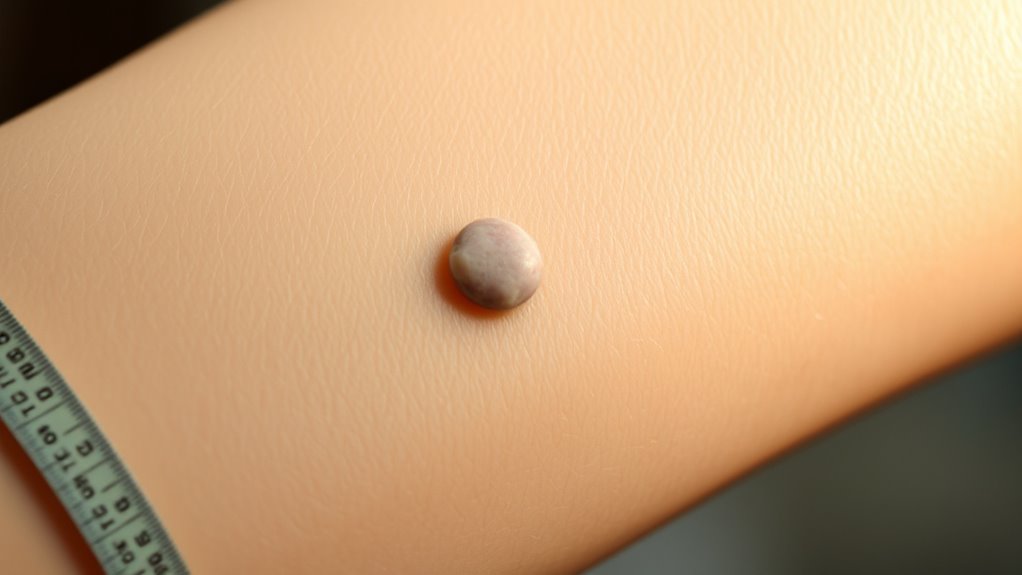
Tracking the size of your moles and spots over time is essential because changes in diameter can signal potential skin cancer. Use a ruler or ruler app to measure the widest part of each spot regularly. Keep a record of these measurements to notice growth or shrinking. Evolution over time also includes observing borders, color, or texture changes. To help, here’s a simple guide:
| Change to Watch | What It Means |
|---|---|
| Increase in size | Possible early sign of concern |
| Irregular borders | Could indicate abnormality |
| Color changes | May signal progression or risk |
| New spots or growth | Seek evaluation promptly |
Consistent monitoring helps catch issues early, prompting professional evaluation when needed. Regular skin checks can also support well-being by reducing anxiety about unseen changes.
Frequently Asked Questions
How Often Should I Perform a Skin Self-Exam?
You should perform a skin self-exam once a month to catch any new or changing moles early. Regular checks help you notice irregularities, such as asymmetry or unusual colors. Choose a consistent time, like after a shower, and use a mirror for hard-to-see areas. Staying vigilant guarantees you can seek medical advice promptly if you spot anything suspicious, improving your chances of catching skin issues early.
Can Skin Cancer Develop in Areas Not Exposed to the Sun?
They say, “Better safe than sorry,” and that’s true for skin health. Yes, skin cancer can develop in areas not exposed to the sun, like your palms, soles, or under nails. Sun damage isn’t the only cause—genetics and other factors matter too. So, don’t forget to check all parts of your body regularly, even those hidden or less likely to get sun. Staying vigilant helps catch issues early.
Are There Any Tools or Apps to Help With Self-Exams?
You might wonder if there are tools or apps to help with self-exams. Yes, several apps are available that guide you through checking your skin for suspicious moles or spots. These apps often include tutorials, photo tracking, and reminder features to encourage regular self-exams. While helpful, they shouldn’t replace professional check-ups. Always consult a healthcare provider if you notice anything unusual or concerning during your self-assessment.
When Should I See a Dermatologist After Noticing a Mole Change?
You should see a dermatologist as soon as you notice a mole change that concerns you. If a mole becomes asymmetrical, changes color, grows rapidly, or develops irregular borders, don’t wait—schedule an appointment promptly. Early detection is vital for skin cancer treatment. Trust your instincts; if something looks or feels different, it’s better to get it checked out quickly to guarantee your health and peace of mind.
Do Skin Cancer Symptoms Differ Between Men and Women?
Imagine a vintage detective scanning clues—your skin’s signals are similar. Men and women may show different skin cancer symptoms: men often develop rougher, dry patches, while women might notice changes in moles or new growths. Though symptoms can overlap, stay alert for any unusual spots, especially if they change or don’t heal. Regular self-exams and dermatologist visits help catch issues early, no matter your gender.
Conclusion
By mastering the basics—spotting symmetry, borders, color, and size—you safeguard your skin’s health. Stay vigilant, and don’t dismiss the signs that seem subtle but could signal serious concerns. Regular self-exams, quick questions, and cautious care create confidence and clarity. Remember, your proactive, prepared approach protects your peace of mind and prevents potential problems. Stay smart, stay sharp, and stay safe—because a small screen scan can save your skin and your life.




